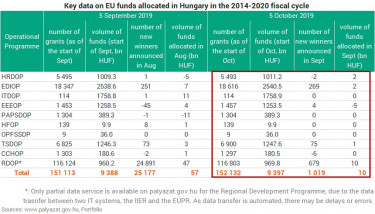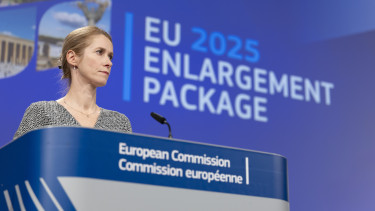EU funds abound, yet disbursements do not surge in Hungary

Funds arrive, yet disbursement spree does not ensue
In our early September analysis, we pointed out that the cabinet had accepted major penalties only to ensure that Brussels keeps the money taps open. This sacrifice allowed the inflow of some HUF 500 billion worth of EU funds into the state budget. This inflow has stopped since then the EU transfer meter has been showing since mid-September that Hungary received EUR 9.8 billion from European Structural and Investment Funds (ESIF) in the 2014-2020 programming cycle. This corresonds to 39% of the country's total 7-year allocation budget, i.e. Hungary is in the mid-section of this particular EU ranking.
You might think that after the settlement of long-standing disputes with brussels, the hungarian cabinet started to accelerate its tender awarding procedures and disbursements, but the numbers do not testify that.
A total of 1,019 tender winners were announced between 5 September and 5 October, most of them in the Rural Development Operational Programme, with allocations totalling HUF 10 billion. Yet disbursements amounted only to HUF 100 bn, although the situation of the budget offered an opportunity to pay a lot more.
Let's see the details!
As the table below shows, a total of 1,019 new tender winners were announced in the period between 5 September and 5 October, with allocations totalling HUF 10 bn. So far there have been over 152,000 winning projects, with funding of nearly HUF 9,400 billion. Almost 25,000 new winners were announced in the Rural Development (RD) programme in August, with grants totalling HUF 47 bn. Most of these decisions have probably been made earlier, but due to IT factors (an upgrade of the tender website) appeared in the publically available statistics only in August.

The jump of 25,000 is also visible in the graph below, and it is also shown that the bulk of projects co-financed by the EU (117,000 out of 152,000) were in the RD programme, given that there are a host of smaller projects worth only a few million forints. The picture is totally different, though, if we examine not the number of projects won, but the size of the allocations. RD projects won only HUF 970 billion of the HUF 9,397 bn worth of total allocations, i.e. these make up less than 10% of the total volume.

As we have noted above, the volume of new EU fund allocations in September amounted only to HUF 10 billion, which is one of the lowest volumes of the last few months. So there was no rush in awarding more EU funds. We believe the decision makers no longer have a mass of new applications to consider, and when it comes to ongoing projects, payments depend on the speed of the implementation. Subsequently, it would be futile from the government's part to speed up advance payments and - with the help of the bonus system - reach new disbursement records right before the record dates as it did previously (see the net EU fund disbursement graph below).
It is also true, though, that the set of rules for the payment of certain advances did become more generous as of August. This may have to do with the government's expectation that larger transfers would soon be made by Brussels. And they were in the autumn. As additional invoices sent to Brussels are cleared, further large funds are likely to be received.

Data show that the volume of all EU funds disbursed between 5 September and 5 October was HUF 106 billion, which takes total disbursement to HUF 6,456 bn. As the chart below attests, the monthly reading of over HUF 100 bn can be considered average in the last year or so.
Hungarian authorities disbursed some HUF 900 billion so far this year, way less than the nearly HUF 2,000 bn targeted in the budget act. Therefore, theoretically at least, money taps should be opened fully in the remaining three months of 2019, otherwise the annual goal will be massively undershot.


Finally, we should also take a look at how the four key indicators of the tender sytem have been doing in the current seven-year programming cycle. The volume of tenders invited has already exceeded HUF 10,400 billion, of which HUF 9,400 bn were allocated. This means that Hungary, theoretically, reached 103% of the 7-year budget. However, if we make an adjustment for the extremely weak forint of the last few weeks, the institutional system may allocate even more funding, considering that EU transfers are made in euros. Local disbursements reached HUF 6,456 billion, which corresponds to 70% of the volume available (theoretically) in the 7-year cycle. About HUF 3,110 bn worth of funding have already been received from Brussels thanks to the major transfers made in September. This corresponds to 39% of the 7-yr budget. This has further narrowed the spread between intensive disbursement from the state budget and the transfer of EU funds that has not been going too smoothly.


Cover photo by MTI/Zoltán Balogh











